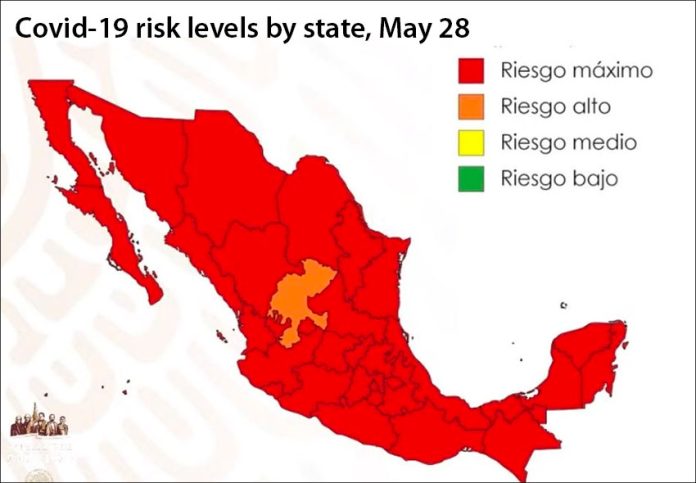Every state except Zacatecas has been allocated a “red light” on the federal government’s stoplight system to determine which coronavirus restrictions can be lifted and where, meaning that nonessential activities will not recommence on Monday in the vast majority of the country.
Deputy Health Minister Hugo López-Gatell presented a map at Friday morning’s presidential press conference that showed that the risk of Covid-19 infection has been deemed to be at the maximum level in 31 of Mexico’s 32 federal entities.
Zacatecas, which currently has 59 active Covid-19 cases, is considered a high risk “orange light” state.
“This evaluation was made on May 28, it’s the most up-to-date and it is what will enter into force on Monday, June 1,” López-Gatell said.
“At the end of the national social distancing initiative, this is how the country is. But, and we’ve said it before, the health safety measures don’t end,” he said, explaining that it will now be the responsibility of state governments to implement restrictions in accordance with the color they are allocated on the stoplight system.

Today’s map paints a much different picture than the first such map, issued on May 13 when the stoplight system was announced. At the time, fewer than a dozen states were given a red light.
The deputy minister said that the stoplight map will be updated on a weekly basis and that federal authorities will subsequently announce the color that corresponds to each state and which activities can resume in each one.
States will be allocated a red, orange, yellow or green light depending on the number of active and new coronavirus cases they have, their hospital admission trends and their hospital occupancy levels.
In “red” states, only essential economic activities will be permitted including the newly-designated sectors of construction, mining and automotive.
Other sectors will be permitted to resume operations once the stoplight switches to orange but with a reduced capacity and/or workforce and with restrictions in place to prevent the spread of Covid-19. People considered to be particularly vulnerable to Covid-19 due to their age or existing health conditions will be permitted to return to work albeit with special protocols in place.
Public spaces will also be reopened during the orange light phase but at a reduced capacity.
Businesses will be able to increase their workforces and capacity once their state has been allocated a yellow light and there will be fewer restrictions in open-air public spaces. However, stricter restrictions will remain in force in indoor spaces such as restaurants, cinemas and theaters.
Once a state is given a green light, students will return to school and other educational institutions and all remaining restrictions on economic and everyday activities will be lifted.
López-Gatell said that Cancún, and the entire state of Quintana Roo, is close to being allocated a yellow light, which corresponds to the “medium risk” level.
“Cancún … is one of the cities that is closest to becoming a medium risk area … and it’s very probable that in the next few days, maybe a week, we will be able to announce that [its risk level] has been lowered,” he said.
That would pave the way for the reopening of Quintana Roo’s tourism sector, which has been hit hard by the coronavirus crisis.
The sector has launched a new tourism campaign to attract visitors to the Caribbean coast state after an expected reopening on June 8.
The World Travel and Tourism Council announced this week that the Mexican Caribbean will be the first destination in the Americas to receive a newly created “Safe Travels” global safety and hygiene certification, backed by the United Nations World Tourism Organization and more than 200 CEOs in the tourism sector.
Source: El Financiero (sp), Reforma (sp)
